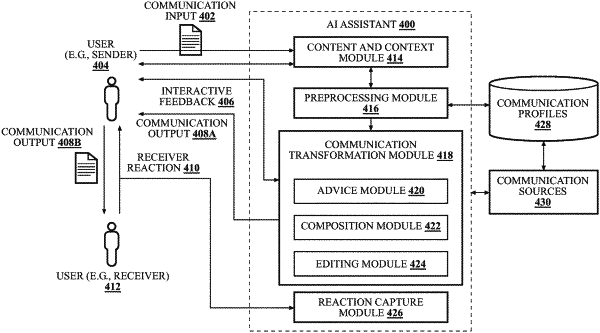| CPC G06F 40/186 (2020.01) [G06F 3/048 (2013.01); G06F 9/453 (2018.02); G06F 17/18 (2013.01); G06F 40/20 (2020.01); G06F 40/232 (2020.01); G06F 40/253 (2020.01); G06F 40/35 (2020.01); G06N 20/00 (2019.01); G10L 15/197 (2013.01); G10L 15/22 (2013.01); H04L 65/765 (2022.05); H04L 67/306 (2013.01); H04N 7/147 (2013.01); H04N 7/148 (2013.01)] | 24 Claims |

|
1. A method of electronic communication assistance, the method comprising:
receiving, via an artificial intelligence assistant computing facility, one or more first electronic communications forming an ongoing conversation thread between a first user and a second user;
receiving, via the artificial intelligence assistant computing facility, a second electronic communication from the first user intended to be received by the second user as part of the ongoing conversation thread;
analyzing, via the artificial intelligence assistant computing facility, the one or more first electronic communications to determine reaction data for the second user;
updating, via the artificial intelligence assistant computing facility, a communication profile for the second user based at least in part on the reaction data;
determining, via the artificial intelligence assistant computing facility, an availability of the second user to receive the second electronic communication;
determining, via the artificial intelligence assistant computing facility and based at least in part on the availability of the second user, a time to send the second electronic communication;
predicting a reaction of the second user to the second electronic communication based at least in part on the updated communication profile;
generating a compositional change to the second electronic communication based at least in part on the predicted reaction; and
transmitting, via the artificial intelligence assistant computing facility, the time and the compositional change to the first user.
|